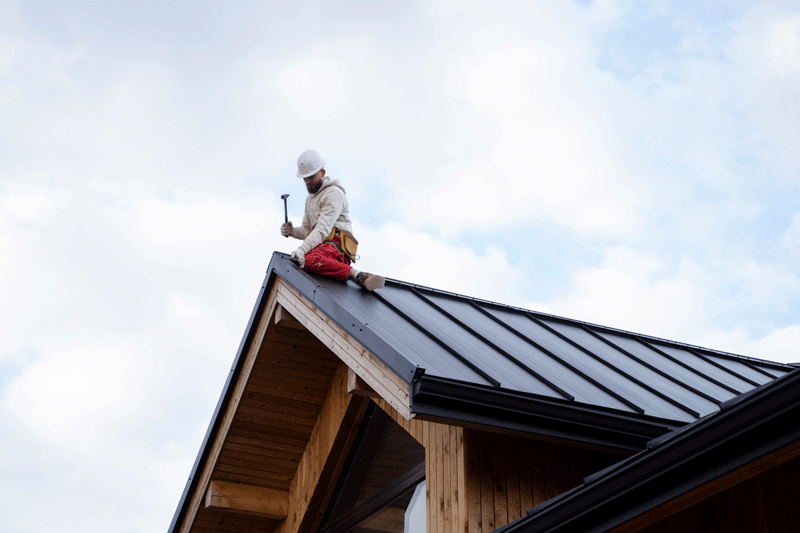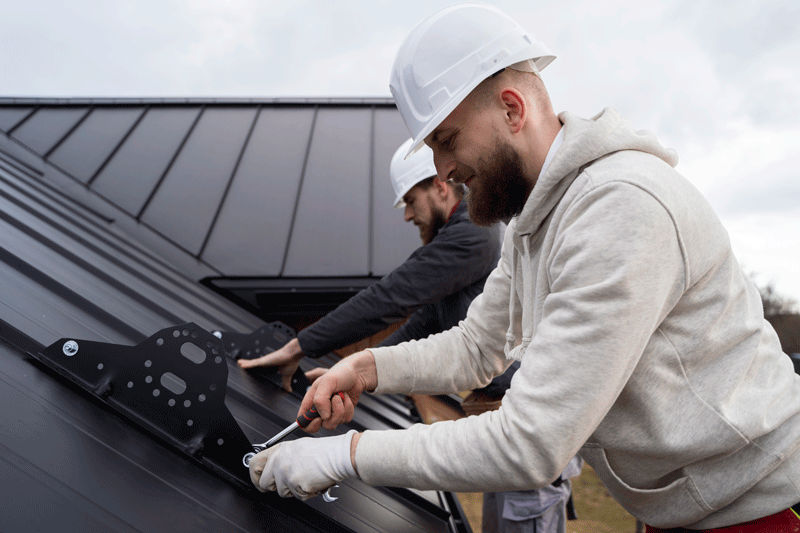Roof flashing is a critical component of your home’s defense against the elements. When properly installed, it directs water away from the joints and vulnerable areas of your roof, preventing leaks and water damage. However, when flashing fails, it can lead to a host of problems. That’s where a roofing company comes in to help deal with the issues.
Causes of Roof Flashing Issues
Age and Corrosion
Over time, even the best materials can succumb to the elements. Flashing made from metals like aluminum, steel, or copper will eventually age and may corrode. This corrosion is often due to exposure to the weather, including rain, snow, and the freeze-thaw cycles that are common in places like Glastonbury, CT. As the metal corrodes, it becomes less effective at channeling water away from the roof’s vulnerable areas. A reputable roofing company like Morrissey Construction can assess the extent of corrosion during a routine inspection and suggest appropriate measures, such as applying protective coatings or replacing old flashing.
Improper Installation
The effectiveness of roof flashing hinges on proper installation. If a roofing company does not install flashing correctly, it can lead to gaps and loose materials, which allow water to seep through. Improper installation may include incorrect sealing, inadequate overlap of materials, or not securing the flashing firmly. These errors can be avoided by hiring a reputable roofing company with a track record of quality installation practices.
Weather-Related Damage
Severe weather conditions, such as heavy storms, high winds, and hail, can damage roof flashing. The force of these elements can bend, dislodge, or even break the flashing, compromising the roof’s integrity. A roofing company in Glastonbury, CT, can provide services to repair or reinforce flashing to withstand local weather patterns.
Structural Issues and Movement
Buildings naturally shift and settle over time, which can lead to the displacement of flashing. This movement can create openings for water to enter, especially if the flashing does not have enough allowance for expansion or contraction. A roofing company experienced in structural dynamics can install flashing that accommodates these movements.
Sealant Failure
Roofing companies use sealants to provide an extra layer of protection where flashing is applied. However, over time, sealants can dry out, crack, or lose adhesion, which can lead to leaks. Regular maintenance by a roofing company can prevent sealant failure by applying new sealant or replacing old flashing as needed.
Identifying Roof Flashing Problems
Identifying problems with roof flashing is critical to maintaining the integrity of a roof. A professional roofing company like Morrissey Construction is skilled at spotting these issues, which can often be subtle and difficult to detect. Homeowners should be aware of the common signs of flashing problems and understand the importance of regular inspections by a roofing company.
Signs of Flashing Failure
- Water Stains on Ceilings or Walls: These are often the most visible indicators that flashing may be failing. Water stains typically appear as dark, damp spots that may grow larger after rainstorms.
- Visible Damage to Flashing: Homeowners may notice bent, rusted, or missing pieces of flashing, especially around chimneys and roof valleys.
- Mold or Mildew in the Attic: The presence of mold or mildew can indicate that there is a lot of moisture entering through compromised flashing.
- Leaks During Rainfall: If leaks are noticed during or after rain, it could be a sign that the flashing is not effectively diverting water.
- Deteriorated Sealant: Cracked or peeling sealant around flashing points to potential issues that a roofing company should address.
Consequences of Ignoring Flashing Issues
Ignoring flashing problems can lead to a cascade of roofing issues. Here are five potential consequences:
- Structural Damage: Continuous water infiltration can weaken the structural components of a home, such as rafters and joists.
- Insulation Degradation: Wet insulation loses its effectiveness, leading to higher energy costs and potential mold growth.
- Interior Damage: Water damage can ruin ceilings, walls, and personal property inside the home.
- Electrical Hazards: Water seepage near electrical wiring can pose serious safety risks.
- Roof System Failure: Prolonged exposure to water can deteriorate the entire roofing system, potentially leading to a costly full roof replacement.
Professional Inspection vs. DIY Assessment
While some homeowners may feel comfortable assessing their roofs, a professional roofing company in Glastonbury, CT, has the expertise to identify issues that may not be apparent to the untrained eye.
- Expertise: Roofing companies have trained professionals who can recognize subtle signs of flashing problems.
- Safety: Roof inspections can be dangerous; roofing companies have the proper equipment and training to conduct them safely.
- Thoroughness: A roofing company will conduct a comprehensive inspection, including areas that homeowners might overlook.
- Diagnosis: Professionals can provide an accurate diagnosis and recommend the best course of action.
- Warranty Preservation: Some roof warranties require regular professional inspections to remain valid.
Limitations of DIY Assessments
- Risk of Injury: Without proper safety equipment, homeowners risk falls and other injuries.
- Missed Signs: Inexperienced individuals may miss early signs of flashing failure.
- Improper Repair Techniques: DIY repairs may not adhere to industry standards, potentially leading to further damage.
- Time Consumption: Properly inspecting a roof can be time-consuming for those unfamiliar with the process.
- Costly Mistakes: Incorrect assessments can lead to unnecessary repairs or failure to address critical issues, resulting in more significant expenses down the line.
Process of Addressing Roof Flashing Issues

When roof flashing issues arise, it’s crucial to address them promptly to prevent further damage to the structure. A professional roofing company like Morrissey Construction is equipped with the knowledge, skills, and tools to resolve flashing problems effectively. The process involves several key steps, from the initial assessment to the final inspection.
Initial Assessment and Diagnosis
The first step a roofing company will take is to perform a thorough assessment of the roof to diagnose the extent of the flashing issues. Here are five key points in this process:
- Visual Inspection: A roofing company will visually inspect the roof for signs of flashing damage, such as rust, cracks, or misalignment.
- Leak Detection: If leaks are present, the roofing company will identify the source and determine if it’s related to faulty flashing.
- Material Assessment: The roofing company will check the type of material used for the flashing and its condition to decide if repairs or replacement are necessary.
- Structural Evaluation: The roofing company will assess the structure around the flashing to ensure there is no underlying damage that needs to be addressed.
- Detailed Reporting: A reputable roofing company will provide a detailed report of their findings, along with recommendations for the next steps.
Choosing the Right Roofing Company
Selecting a qualified roofing company is critical for ensuring that flashing issues are properly addressed. Here are five considerations when choosing a contractor:
- Experience: Look for a roofing company with extensive experience in flashing repairs and installation.
- Credentials: Verify that the roofing company has the necessary licenses and insurance to perform roofing work in your area.
- Reputation: Check reviews and ask for references to ensure the roofing company has a solid reputation for quality work.
- Warranty: Choose a roofing company that offers a warranty on their work, providing peace of mind that the repairs will last.
- Estimate Clarity: Ensure the roofing company provides a clear and detailed estimate outlining all the costs involved in the flashing repair or replacement.
Repair vs. Replacement Options
Once the initial assessment is complete, the roofing company will recommend either repairing the existing flashing or replacing it entirely. Here are five points to consider in this decision:
- Extent of Damage: If the damage is localized and minor, a roofing company may be able to repair the flashing. However, widespread or severe damage will likely require replacement.
- Age of Flashing: Older flashing that is nearing the end of its lifespan should be replaced to prevent future issues.
- Cost Considerations: A roofing company will provide cost estimates for both repair and replacement, allowing homeowners to make an informed financial decision.
- Long-Term Solutions: While repairs may be less expensive upfront, a roofing company may recommend replacement for a more durable and long-term solution.
- Compatibility with Existing Roof: The roofing company will ensure that any new flashing is compatible with the existing roof materials and design.
Step-by-Step Guide on How Flashing is Repaired or Replaced
The actual process of repairing or replacing flashing is meticulous and requires a skilled hand. A roofing company will typically follow these steps:
- Removal of Old Flashing: If replacement is necessary, the roofing company will carefully remove the existing flashing without damaging surrounding materials.
- Surface Preparation: The roofing company will clean and prepare the area to ensure that the new flashing adheres properly.
- Installation of New Flashing: The roofing company will cut and shape the new flashing to fit precisely and secure it in place, using appropriate fasteners and sealants.
- Sealing: A roofing company will apply sealant around the edges of the flashing to create a watertight barrier.
- Final Inspection: After the repair or replacement is complete, the roofing company will conduct a final inspection to ensure the flashing is properly installed and functioning as intended.
Roof flashing – how to inspect for problems and how to flash it right
Preventative Measures and Maintenance
Preventative measures and regular maintenance are key strategies to extend the life of roof flashing and prevent potential issues. A trusted roofing company in Glastonbury, CT, can provide homeowners with the necessary services to ensure their roof remains in optimal condition. Here’s how a roofing company can help maintain the integrity of roof flashing:
Regular Maintenance Tips
Regular maintenance is the first line of defense against flashing deterioration. Here are five maintenance tips a roofing company might recommend:
- Routine Inspections: Schedule inspections with a roofing company at least once a year or after severe weather events to check for any signs of flashing damage.
- Debris Removal: Keep the roof clear of debris, such as leaves and branches, which can trap moisture and lead to corrosion of the flashing.
- Gutter Maintenance: Ensure gutters and downspouts are clear of obstructions to prevent water buildup, which can affect the flashing’s ability to divert water properly.
- Trim Overhanging Branches: A roofing company may suggest trimming any branches that hang over the roof to reduce debris accumulation and physical damage to the flashing.
- Sealant Checks: Have a roofing company check the condition of the sealant used around the flashing and reapply it as necessary to maintain a watertight seal.
Long-term Strategies to Prevent Flashing Issues
Implementing long-term strategies can help in preventing future flashing issues. A roofing company can assist in developing these strategies:
- Quality Installation: Ensure that the initial installation of flashing is done by a reputable roofing company to guarantee quality workmanship.
- Material Selection: Choose high-quality materials for flashing that a roofing company recommends for their durability and suitability for the local climate.
- Ventilation Improvement: A roofing company can improve roof ventilation to reduce the risk of ice dam formation, which can damage flashing.
- Regular Upkeep: Establish a maintenance plan with a roofing company for regular check-ups and upkeep of the roof and its components.
- Education: Homeowners should educate themselves about their roofing system, and a roofing company can provide valuable information on how to spot potential issues.
Frequently Asked Questions (FAQs)
How often should I have my roof flashing inspected by a roofing company?
It’s recommended to have your roof flashing inspected by a professional roofing company at least once a year. However, if you live in an area with severe weather conditions or have an older roof, more frequent inspections may be necessary. A roofing company can provide a more precise inspection schedule based on your specific circumstances.
What are the signs that my roof flashing may need attention from a roofing company?
While some signs such as leaks or visible damage have been discussed, other indicators that your roof flashing may need a roofing company’s attention include unusual noises during wind or rain, a sudden increase in energy bills (which could indicate heat escaping through gaps in the flashing), and visible rust or discoloration on the flashing material.
Can a roofing company repair flashing without replacing my entire roof?
Yes, a roofing company can often repair or replace flashing without the need for a full roof replacement. The feasibility of this depends on the extent of the damage and the condition of the surrounding roofing materials. A professional roofing company will assess the situation and recommend the best course of action.
Is it possible to upgrade the material of my roof flashing during a repair or replacement?
Absolutely. When a roofing company conducts repairs or replacements, it’s an excellent opportunity to upgrade the flashing material. A roofing company can advise on the best materials for your roof’s specific needs and the local climate, potentially increasing the longevity and effectiveness of the flashing.
How does the choice of a roofing company affect the longevity of my roof flashing?
The choice of a roofing company is crucial as experienced professionals use quality materials, ensure proper installation, and can provide expert advice on maintaining your roof flashing. A reputable roofing company will also stand behind their work with a warranty, offering added assurance of the flashing’s longevity.
What should I expect in terms of maintenance after a roofing company has repaired or replaced my flashing?
After a roofing company has repaired or replaced your flashing, they should provide you with a maintenance plan that includes regular inspections, cleaning guidelines, and a schedule for potential re-sealing. They should also inform you about any signs of wear and tear to watch out for between inspections.
Can a roofing company install flashing on a roof that didn’t previously have it?

Yes, a roofing company can install flashing on a roof that previously lacked it. This process may involve additional steps, such as modifying certain areas of the roof to accommodate the new flashing. A roofing company will evaluate your roof and determine the best way to integrate flashing into the existing structure.
Will my homeowner’s insurance cover the cost of repairing roof flashing?
Homeowner’s insurance policies vary, but many cover damage that is sudden and accidental. However, they often do not cover issues due to wear and tear or lack of maintenance. A roofing company can provide documentation of the flashing damage, which you can submit to your insurance company to determine if the repairs are covered.
Secure Your Shelter with Morrissey Construction
With years of experience, a commitment to quality, and a deep understanding of the local climate, Morrissey Construction is the go-to roofing company for all your flashing needs. Don’t wait for minor flashing issues to become major headaches. Contact Morrissey Construction today and rest assured that your roof is in the hands of experts!


